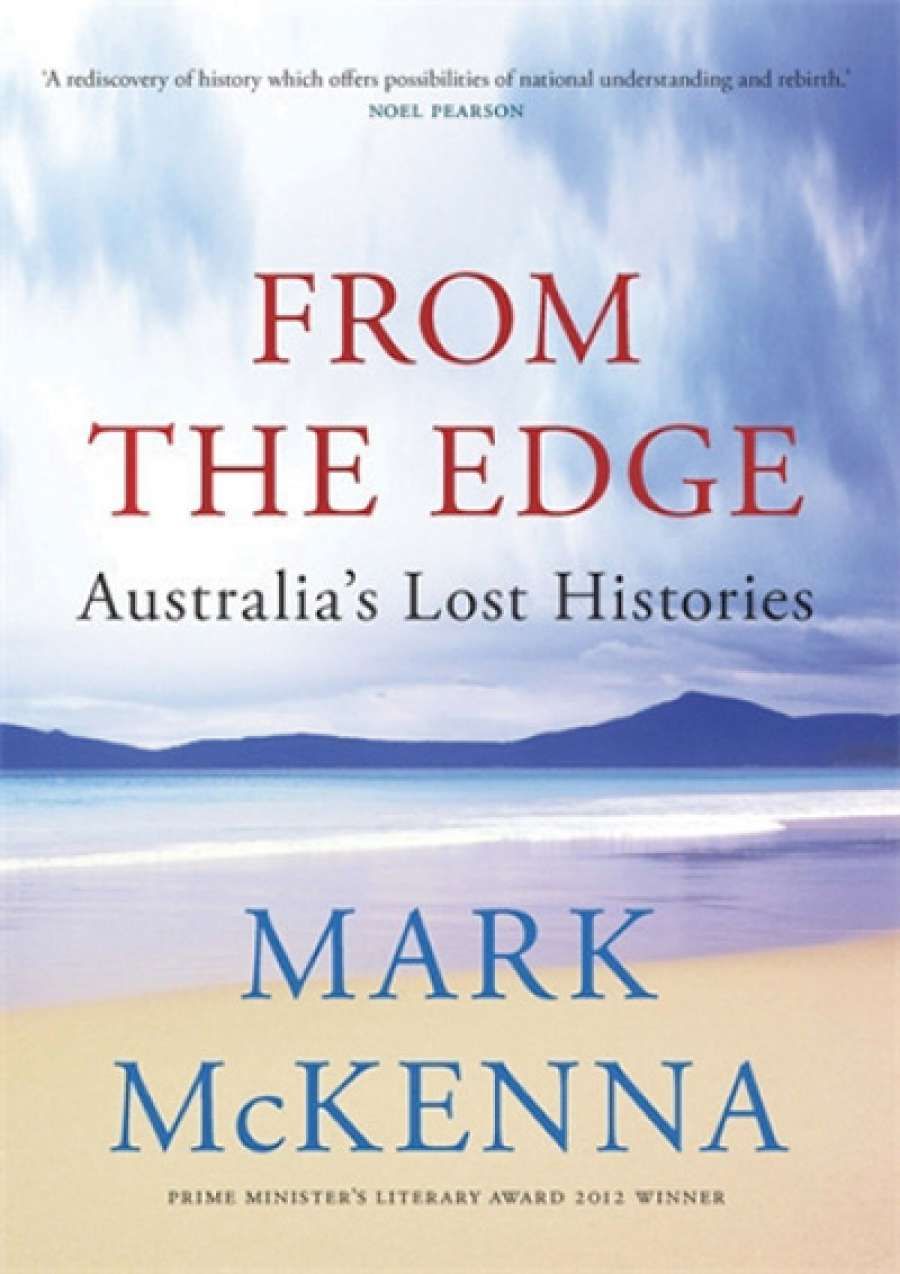
- Free Article: No
- Contents Category: Australian History
- Custom Article Title: Michael Winkler reviews 'From the Edge: Australia’s lost histories' by Mark McKenna
- Custom Highlight Text:
There is a well-meaning musician who performs intermittently in Central Australia. When he plays his hit song, he tries to augment the lyrics by chanting the ...
- Book 1 Title: From the Edge
- Book 1 Subtitle: Australia’s lost histories
- Book 1 Biblio: Melbourne University Press, $34.99 pb, 271 pp, 9780522862591
His method – starting with place and foregrounding story – echoes the Indigenous approach, where everything starts and ends with Country and the oral tradition has long been paramount. He posits, ‘Perhaps we would understand Australia differently ... if we started from the ground up, from the local and the regional perspective.’
The ongoing search for national identity – as mad and doomed as Lasseter’s treasure hunt – has conventionally centred on the inland, but McKenna finds his stories on the edges of the continent, at approximations of the cardinal points. At each place he etches the bloody historical narrative, creating intaglios of tragedy and dashed hopes.
The best story is situated in the south, a ripping tale full of drama, suspense, courage, crisis, rhythm. In 1797 a cargo-laden ship sank beside a speck of island in Bass Strait. William Clark and a crew of British and Bengali sailors crossed to the mainland in a longboat which was dashed to pieces on Ninety Mile Beach. They set out to walk 700 kilometres to Sydney, a settlement they had never seen. Their highly variable experiences with the different groups they encountered exemplify the ‘extraordinary regional diversity’ that McKenna emphasises. Most convergences were respectful, curious, even tender, ‘each searching tentatively for proof of the other’s humanity’. Even when violence occurred, it seems a product of fear rather than aggression.
For the northern story, McKenna visits West Arnhem Land to trace the doomed settlement of Port Essington. From 1838 to 1849 a small group of Britons was embedded in a disastrous attempt to create a ‘new Singapore’. Here, narrative gives way to image. McKenna shows us women inside ironstone Cornish cottages, clothed from head to toe, cooking over open fires in oppressive tropical humidity. The camp commander engages local men to bring ashore the frame of a church, a surreal enterprise reminiscent of the steamship lugged over a jungle-clad hill in Werner Herzog’s Fitzcarraldo (1982).
Port Essington was ‘an unusual laboratory of mutual fascination and cultural exchange’. Into the midst came a shipwrecked Italian priest, quixotic Father Angelo. Flawed, remarkable, Angelo quickly became conversant with local languages, compiled a dictionary, and struggled to create converts. ‘For every step that broke down the chasm of cultural difference, there was a countervailing push to remind both sides of the enormity of the divide.’
The third and fourth stanzas of the book are situated at coastal points west (Murujuga, near Karratha) and east (Cooktown). These are records of indiscriminate killing and deliberate acts of bastardry and dispossession. The commonality of horrors during the second half of the nineteenth century in places more than 3,000 kilometres apart suggests these stories are emblematic rather than unique. ‘[A]llegations of forced labour, chain gangs, incarceration, severe beatings, stockwhip floggings, shootings and an “unquestionable system of slavery” abounded.’ McKenna provides enough documentation of frontier massacres to stopper the most pettifogging Windschuttle acolyte.
There is a consistency within the disparate stories that suggests patterning: humans tending to act like humans, regardless of race, place, or time. Throughout, there are transfixing accounts of what Jane Mulcock called the ‘difficult, delicate negotiations of belonging’. Contact changes both parties. Non-Indigenous Australians have had to find a way to live in this country. Indigenous Australians have had to find a way to live with more recent arrivals.
McKenna shows the way language functions to both facilitate and indicate the negation of Indigeneity, creating a space in which physical erasure can occur. One illustration: the largest hill near Murujuga, Jarndunmunha, was renamed Mount Nameless. We see the devilish paradoxes and ambiguities of history. An example: much of the slaughter of Guugu Yimithirr and other traditional residents near Cooktown was performed by the Native Police, predominantly Aboriginal men from southern Queensland.
 Jarndunmunha, renamed 'Mount Nameless' (Wikimedia Commons)
Jarndunmunha, renamed 'Mount Nameless' (Wikimedia Commons)
McKenna shows but does not belabour ironies: the helplessness of overlord Europeans reliant on ‘primitive’ locals; the way land ownership was transferred to Britain by hoisting a symbol and declaiming some magic words, the sort of thing that, reversed, would be derided as mumbo-jumbo. He also guides us through topsy-turvy scenarios that mimic a modern Australia in which privileged white men fume and fulminate about the injustice of being labelled racist merely because they have been, well, racist: ‘the descriptions of war and conflict that have survived in the historical record do more than just reflect the banality of the killing: they also reveal how the miners and pastoralists perceived themselves as victims.’
There are small errors (Ninety Mile Beach is not in north-east Victoria; ‘decimated’, is used incorrectly, twice) and a few arguable assertions are expressed as fact, but these are flea bites on the muscular corpus of a significant work. The stately book design and abundance of photographs do justice to the text.
It is half a century since W.E.H. Stanner spoke in his Boyer Lectures of ‘The Great Australian Silence’ about the erasure of Indigenous inhabitants from Australian history: ‘What may well have begun as a simple forgetting of other possible views turned under habit and over time into something like a cult of forgetfulness practised on a national scale.’
Mark McKenna’s careful work is a timely corrective. We need to hold simultaneously in the national imagination detailed, sorrowful knowledge of violent dispossession and the rich possibilities of cooperation and growing together. Good intentions have never been enough.


Comments powered by CComment